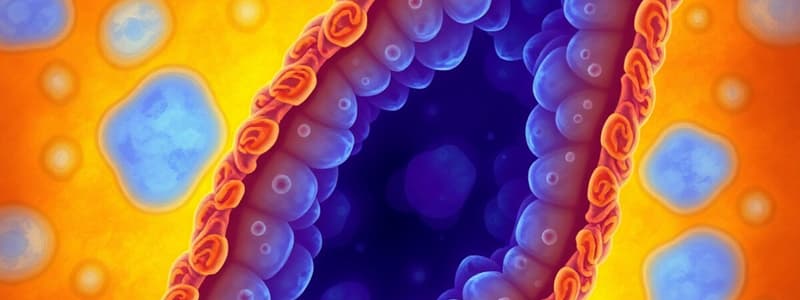Podcast
Questions and Answers
What is the primary function of epithelial tissue in the lining of the small intestine?
What is the primary function of epithelial tissue in the lining of the small intestine?
- Support for connective tissue
- Filtration of blood plasma
- Absorption of nutrients (correct)
- Protection from mechanical damage
Which characteristic does NOT apply to epithelial tissue?
Which characteristic does NOT apply to epithelial tissue?
- Contains blood vessels (correct)
- Forms continuous sheets
- Regenerates quickly
- Has a basement membrane
What type of epithelial tissue is characterized by a single layer of flattened cells?
What type of epithelial tissue is characterized by a single layer of flattened cells?
- Stratified Squamous Epithelium
- Simple Columnar Epithelium
- Simple Cuboidal Epithelium
- Simple Squamous Epithelium (correct)
What is the role of the apical surface in epithelial tissue?
What is the role of the apical surface in epithelial tissue?
Which type of tissue is classified based on its shape and layering?
Which type of tissue is classified based on its shape and layering?
What is the primary function of simple cuboidal epithelium?
What is the primary function of simple cuboidal epithelium?
Which type of epithelium is characterized by having goblet cells and microvilli?
Which type of epithelium is characterized by having goblet cells and microvilli?
Where is pseudostratified epithelium typically found?
Where is pseudostratified epithelium typically found?
What distinguishes transitional epithelium from other types of epithelium?
What distinguishes transitional epithelium from other types of epithelium?
What type of gland secretes hormones directly into the bloodstream without the use of ducts?
What type of gland secretes hormones directly into the bloodstream without the use of ducts?
Flashcards
Epithelial Tissue
Epithelial Tissue
A tissue composed of cells arranged in continuous sheets, forming coverings and linings of surfaces, with various functions such as protection, absorption, filtration, and secretion.
Simple Squamous Epithelium
Simple Squamous Epithelium
A single layer of flattened cells. It is primarily involved in absorption and filtration.
Basement Membrane
Basement Membrane
A thin layer of tissue that anchors epithelial cells to the underlying connective tissue.
Avascularity (Epithelial)
Avascularity (Epithelial)
Signup and view all the flashcards
Epithelial cell layers
Epithelial cell layers
Signup and view all the flashcards
Simple Cuboidal Epithelium
Simple Cuboidal Epithelium
Signup and view all the flashcards
Simple Columnar Epithelium
Simple Columnar Epithelium
Signup and view all the flashcards
Stratified Squamous Epithelium
Stratified Squamous Epithelium
Signup and view all the flashcards
Exocrine Glands
Exocrine Glands
Signup and view all the flashcards
Transitional Epithelium
Transitional Epithelium
Signup and view all the flashcards
Study Notes
Tissue Introduction & Epithelial Tissue
- Human bodies develop from single to multicellular cells, specializing during development.
- The body is an interdependent system, and the malfunction of one cell group can be catastrophic.
- Cells specialize into tissues, which are then interspersed into organs.
- Tissues are groups of similar cells with similar structures and functions.
Types of Tissues
- Epithelium: Coverings and linings of surfaces.
- Connective: Support (e.g., bone, ligaments, fat).
- Muscle: Movement.
- Nervous: Control (e.g., brain, nerves, spinal cord).
Function of Epithelial Tissue
- Protection: Skin protects from sunlight, bacteria, and physical damage.
- Absorption: Lining of the small intestine absorbs nutrients into the blood.
- Filtration: Lining of kidney tubules filters wastes from blood plasma.
- Secretion: Different glands produce perspiration, oil, digestive enzymes, and mucus.
Characteristics of Epithelial Tissue
- Forms continuous sheets (like tiles).
- Apical Surface: Top surface of epithelial cells bordering an open space (lumen).
- Basement Membrane: The underside of epithelial cells anchoring them to connective tissue.
- Avascular: Lacks blood vessels.
- Nourished by connective tissue.
- Regenerates and repairs quickly.
Classification of Epithelial Tissue
- Cell Shape:
- Squamous: Flattened, like fish scales.
- Cuboidal: Cube-shaped.
- Columnar: Column-shaped.
- Cell Layers:
- Simple: One layer of cells.
- Stratified: Multiple layers of cells.
- Named for the cell type at the apical surface.
Simple Squamous Epithelium
- Structure: Single layer of flattened cells.
- Function: Absorption and filtration.
- Location: Walls of capillaries, air sacs in lungs, and forms serous membranes in body cavities.
- It is not a good protective layer.
Simple Cuboidal Epithelium
- Structure: Single layer of cube-shaped cells.
- Function: Secretion and transportation in glands, filtration in kidneys.
- Location: Glands and ducts (pancreas & salivary), kidney tubules, covers ovaries.
Simple Columnar Epithelium
- Structure: Elongated layer of cells with nuclei at the same level.
- Function: Absorption, protection, and secretion.
- Location: Linings of the entire digestive tract.
- Special Features:
- Microvilli: Increase surface area and absorption rate.
- Goblet cells: Produce protective mucus.
Pseudostratified Epithelium
- Structure: Irregularly shaped cells with nuclei at different levels, appearing stratified but not. All cells reach the basement membrane
- Function: Absorption and secretion.
- Goblet cells produce mucus.
- Cilia (larger than microvilli) sweep mucus.
- Location: Respiratory linings & reproductive tract.
Stratified Squamous Epithelium
- Structure: Multiple layers (usually cuboidal/columnar at the bottom, squamous at the top).
- Function: Protection. Keratin (protein) in older cells waterproofs and toughens the skin.
- Location: Skin (keratinized), mouth, and throat.
Transitional Epithelium
- Structure: Many layers, cells at the base are cuboidal or columnar, surface cells can vary. Changes between stratified and simple as tissue stretches
- Function: Allows stretching (changing size).
- Location: Urinary bladder, ureters, & urethra.
Glands
- One or more cells that make and secrete a product.
- Secretion: Protein in an aqueous solution (e.g., hormones, acids, oils).
- Endocrine Glands: No ducts, release secretion into blood vessels (e.g., hormones, thyroid, adrenal, pituitary).
- Exocrine Glands: Contain ducts, empty onto epithelial surfaces (e.g., sweat, oil, salivary, mammary).
Shapes of Exocrine Glands
- Branching: Simple (single, unbranched duct) or compound (branched).
- Shape: Tubular (shaped like a tube), alveolar (shaped like flasks or sacs), or tubuloalveolar (both tubes and sacs).
Modes of Secretion
- Merocrine: Released by exocytosis, without altering the gland (e.g., sweat and salivary glands).
- Holocrine: Gland ruptures and releases secretion and dead cells (e.g., sebaceous glands).
Studying That Suits You
Use AI to generate personalized quizzes and flashcards to suit your learning preferences.




